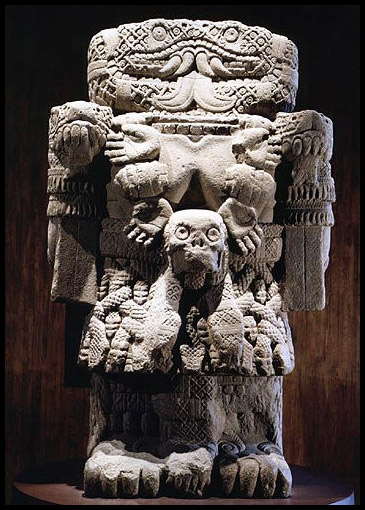|
| |
Coatlicue: The Goddess, demon, monster, and Masterpiece

Aztec Coatlicue figure, Tenochtitlan
Circa 1487-1521
Stone, Height 3.5 meters
Museo Nacional de Antropologia
Mexico City, Mexico
Coatlicue: The Goddess, demon, monster, and Masterpiece
The great statue of Coatlicue was torn down from the great temple of Tenochtitlan where she had reigned as a goddess before the Spanish Conquistadors buried her as a pagan idol. She remained buried until August 13th, 1790, when city workers discovered the colossal statue as they were removing pavement from the Plaza Mayor in Mexico City. They unearthed it and discovered that it was a ten ton sculpture of the Aztec deity Coatlicue which translates to “She of the skirt of serpents.” The colonial mayor arranged for it to be taken to the Royal and Pontifical University of Mexico as a “monument of American antiquity.” The Aztec statue was placed in the university collection of plaster replicas of Greco-Roman works. The professors at the university decided the sculpture should be buried back in the place it was found. The Aztec image not only rekindled the Indigenous Natives memory of their ancient beliefs but artistically its very presence was vulgar compared to the other collections in the cloister.
She was again excavated briefly in 1804 so that German Baron Alexander von Humboldt could examine the massive sculpture; she was soon reburied for her repulsive image.
The Great Coatlicue, so named by archaeologists to distinguish it from other sculptures of the same deity, was not excavated until years after the Mexican Independence (September 16, 1810). She was kept hidden in a corner of a patio of the university, then behind a screen, as an object of curiosity and embarrassment; later it was placed in a visible location, as an object of scientific and historic study. Today she occupies a central position in the great hall dedicated to Aztec / Mexica culture in the world renowned National Museum of Anthropology in Mexico City. Although the Coatlicue monolith was always the same object, the meanings attributed to here metamorphosed from Goddess to demon, from demon to monster, and from monster to present day Masterpiece.

This BrownPride.com feature is inspired and dedicated to Mexican author, poet, diplomat, and Nobel Laureate (Winner of the Nobel Prize in Literature in 1990) Octavio Paz (b. March 31, 1914 – April 19, 1998).
|
|
|
|




